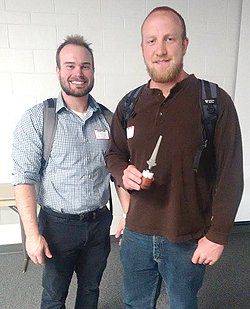The two medical research students that brought their research to Emery High may have looked like hometown boys in the flannel and boots and that’s because they were. Colton Leavitt and Tyler Bean, taught a two day workshop for the Emery High science programs. Colton is a graduate from Emery High School, and Tyler a graduate from Carbon High School, and both do research for the medical community at the University of Utah.
Leavitt, who works in a lab for the Western Institute for Bio-Medical Research at the Veterans Administration Hospital, coordinated the event. His intent is to teach the students about opportunities in science technology and math as part of the university’s outreach program. It wasn’t just a lecture, the students were engaged in reading and dialog during the event. In preparation for the presentation, students were challenged to read a medical journal article titled, ” Fifteen Years of Experience with Integral-Leg Prosthesis.” According to Leavitt, “Being able to read scientific writing and the ability to interpret graphs is a skill that will serve you well on the ACT, in college and life. Being an educated person is being proficient at obtaining knowledge on your own. ”
“I thought you had to be a white coat genius,” commented Logan Labrum after the session. Leavitt’s point was that anybody with a passion, desire and a problem to solve can be involved in scientific research. The research that Leavitt is involved in is Percutaneous Osseointegrated Prosthetic Implants. The hope is that one day, amputees can be fitted with artificial limbs that help them return to an active lifestyle after tragedy.
One of the challenges facing this project is that skin will only attach to a bioactive surface, therefore infections often arise after the implant. Leavitt’s research group has been working on a synthetic fluorine-phosphate compound much like tooth enamel. Garret Stilson noted that these are the very same ions that we have learned in chemistry this year, that the medical research is not a foreign topic to chemistry students.
Derek Anderson said that he has always seen himself in technology and medicine but didn’t know how to get started. Leavitt pointed out that is not uncommon in the early years. It all starts with curiosity about how systems work. Often researchers stumble into a problem then devise a solution. That is the nature of science and research.
Tyler Bean’s focus is on vascular research. Working with mice, they are selecting genes that improve blood flow in veins and arteries damaged by aging or disease like diabetes. Where Leavitt’s research involves physics and chemistry, Bean’s research is closely related to biology and genetics. The branch of science one focuses on in their career is not as important as the passion that drives the curiosity.
Approximately 200 students took part in the workshop. One of the most valid points of the two day enterprise is that Emery and Carbon High Schools teach the basic core science principles which empower students with the tools to pursue careers in science, math and technology.
Local medical researchers visit EHS

"Colton Leavitt and Tyler Bean are Pre-Med students from the University of Utah. They brought their research to share with Emery High Students. Colton poses with an artificial leg prosthesis, used in research to develop a human implant."
